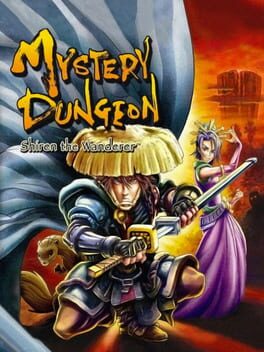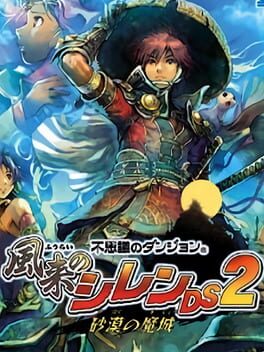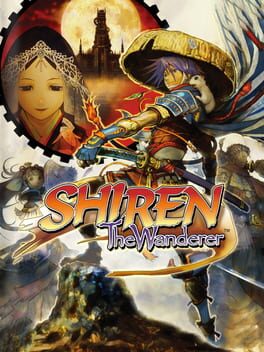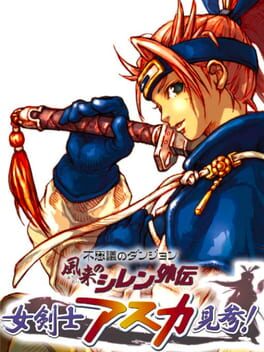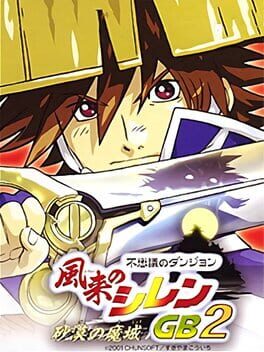

A remake of Fushigi no Dungeon 2: Fuurai no Shiren
Shiren and his pet weasel Koppa have set out to find golden city El Dorado and the lair of the legendary Golden Condor. Along the way they'll make new friends, visit caves and dungeons, and kill the heck out of a myriad of monsters in this turn-based roguelike.
Also in series
Reviews View More
Great game, but falls short of the original. This was the first mystery dungeon I played and I absolutely loved it. Now after playing many more games in the series and looking at these games with a more critical lens, I find myself agreeing with the dedicated Japanese Shiren fan base. Everything Shiren DS does well, it fumbles at something else that the SNES version did right. The new dungeons are a nice idea, but they're all carry-ins. New monsters? That sounds fun! Oh, they exist impede progress and destroy items...
Honestly just look at the problems listed on this page: https://w.atwiki.jp/gcmatome/pages/2344.html
Honestly just look at the problems listed on this page: https://w.atwiki.jp/gcmatome/pages/2344.html
I can't rate the game.
At first, it is good and addictive. There are many ideas and at the same time it sticks to formula "less is more". There are not lot of mechanics but player will use all of them for all the time. I really praise the design.
I like that the roguelike part is not only about beating one floor by another but there are also villages with NPCs. Dialogues covers lore and some random events player can experience at his path.
I gaved up only because the difficulty. If you will research YouTube you will not find videos how anyone will get latest floor. At some moment there is high chance to be killed just in one shot.
So I've got lot of fun from this, but just don't feel I should spend more of my time on it.
At first, it is good and addictive. There are many ideas and at the same time it sticks to formula "less is more". There are not lot of mechanics but player will use all of them for all the time. I really praise the design.
I like that the roguelike part is not only about beating one floor by another but there are also villages with NPCs. Dialogues covers lore and some random events player can experience at his path.
I gaved up only because the difficulty. If you will research YouTube you will not find videos how anyone will get latest floor. At some moment there is high chance to be killed just in one shot.
So I've got lot of fun from this, but just don't feel I should spend more of my time on it.
The Mystery Dungeon games feel especially important to video game history, and if you do a little bit of research, you'll find that they are. These were roguelikes that did their fair share to shape various elements of modern day games and furthermore brought the aforementioned genre to consoles. This isn't especially surprising given they came from the brainchild of Koichi Nakamura, Chunsoft. A company whose legacy also includes visual novels, their sound novel variants, and the quintessential Japanese RPG format. They're a group that's done quite a bit for video games, but personally, this wasn't what pushed me to play Shiren the Wanderer. That was ultimately just a latent sense of intrigue. The Pokémon Mystery Dungeon games are very well known, and there's a cavalcade of other properties that were given their very own Mystery Dungeon entries. But Shiren, that always stood out to me as the only one that's an original property. No pre-established world to fit itself into, just the pure vanilla Mystery Dungeon experience. Though, I suppose you can't truly call it vanilla when it wasn't even the first Mystery Dungeon game. That would be the Dragon Quest sub-series. Either way, I knew it had some sort of feudal Japanese setting, and was a roguelike, two things I could get behind fairly easily. And as luck would have it, I happened to pick the remake of the very first entry by chance, which fit the bill even more since I usually like to see where a series gets its start.
After playing the game for a bit, I came about another aspect of it that makes me unsure whether I'd call this your vanilla Mystery Dungeon. It has personality, and a sheer boatload of it. The setting is a lot more fantastical than one might expect and features unrealistic elements aplenty in its world and very zany enemy designs. The latter being good enough that I ended up buying a book with some of the art from the original SFC release dubbed the "Character Debut Book". The game's central design revolving around repeated play made it a necessity to have their designs be memorable, but they got far more clever with this game than that.
Throughout the game, simple events happen when you interact with the NPCs, and much like a standard RPG these end up being side quests that carryover through subsequent plays. Granting the player party members, a restaurant to get stat buffs at during your playthrough, and some of the best items in the game, just to name a few. The cutscenes leading into these rewards are charming and have a great sense of humor. Take the party members, for instance, who are somewhat odd to say the least. Your first encounter with one of them ends with you being blinded as the butt of an insinuating joke, only for you to have to save them from trouble later because they were caught by other victims post-blinding (yeah they also just blind whomever they point at somehow). In the 70 or so hours it took me to beat all of the game's dungeons, maybe only about 30 minutes of those were spent watching cutscenes and reading dialogue. So it's really nice that what little characterization there is does a pretty good job at it.
So, it was certainly a neat surprise to find that the entire series has a fantastic art style and for this entry to have some little stylistic hooks with its writing and whatnot. But I picked this game up for gameplay, so how does that play out? For starters, this game is brutal, as expected for a roguelike, but the game has various ways of softening things up while still being a challenge. I mentioned the sidequests, but there are also warehouse buildings you can use to store your equipment in. These are a total boon for your progress, although it took me a little while to figure out the best way to use them. There are a lot of items you can find on your adventures, some of them a necessity, like the riceballs to keep you from dying of hunger. Others are only as good as the strategies you employ with them, and a small minority of items are outright harmful to you. So eventually, I learned it best to hold on to my weapon and shield, since upgrading them is a necessity of beating the game. And as I learned which items I had the best strategies for, my warehouses became far more useful. Some items I didn't even know the usefulness of until I went through the final and hardest dungeon in the game. Take the Staff of Postpone, which slows down enemies. Just use that, and ignore them, no more debilitating status effects for you most likely. I hadn't learned how wise it was to not fight every single enemy I came across for ages. But the fact that I didn't says a lot about the array of strategies you can have playing this. This game's like chess, if chess was more like a two-player Dungeons & Dragons, and the dungeon master despises you. Turns only happens after you make a move, so you always have time to stop and think. But you still need to think ahead. After all, there's only so much you can do on the fly, so you have to be ready for the worst. Once you get good at that, the game's a breeze.
One way the game teaches you of its multitudinous complexity is through Fay's Puzzles. These dial in that chess analogy I made in how they play. You're often in a room with strong enemies and traps that can kill you quickly, so the focus is on learning how to avoid these and use items to reach the exit. Doing so also nets you a random prize you can use or store at your discretion. I found these to be rather addictive because of their bite-sized nature; clearing them all within the first 10 hours of my playthrough. Depending on your preferences though, you can do these gradually. Though, in order to get the last bonus dungeon you'll need to complete them all.
Touching upon the difficulty again. To my understanding, this game's not even the hardest and most complex in the series, but it seems to be more unforgiving at times. This version has a rescue request system, so that if you die, you can reach out to another player and have them go through the dungeon to give you another shot. Enough people do still actively play this game, so if you ask around, you'll get some help. Or you could also use a fan-made password generator to save yourself. I didn't like using the latter very much, but since you can only be rescued three times at most in a run before failing, I'd say it's fair. Though there are a few occasions where rescuing isn't an option at all. For example, if you harass the shopkeeper in any way, he'll attack you for very high damage. And if you steal, you'll have to contest with both that and officers (and their dogs) chasing after you. These are manageable if you are well prepared. But if you're unfortunate enough to accidentally select "Throw" instead of the "Put" option when trying to sell something, things might not end very well for you. That sucked when it happened to me personally, and was a bit of a mood killer. Especially considering that this was a game I enjoyed the most in bursts, and redoing the last hour of progress wasn't something I wanted to do in that moment.
Oddly enough, while I had a ton of fun and have fond memories of this game, I'll be giving it a 9/10 for now. I think this decision mainly comes down to the game being better in bursts. A bit of a strange way to score it maybe, so perhaps that'll change. Another reason is that some of the bonus dungeons were a bit lacking. Apparently all of them in the SFC version are a fair challenge, but some of them the new and remade dungeons alike were just a tad too easy here, gimmicks aside. Though the final dungeon in the original is also slightly easier as well it seems, so I guess I'll see for myself eventually. But simply put, if you want a game that's both fun and at times tense and slightly torturous, this is great! Even greater is how each play is different for everyone, making it a pleasure to talk about with others in ways I haven't really seen before, and that includes other games with rogue elements. Add to it that the game has plenty of charm and you've got a roguelike that you might just spend 1300 hours playing. As for me, I'll be applying those 1300 hours across the entire series, because wow there's a lot of Shiren and even more Mystery Dungeon.
After playing the game for a bit, I came about another aspect of it that makes me unsure whether I'd call this your vanilla Mystery Dungeon. It has personality, and a sheer boatload of it. The setting is a lot more fantastical than one might expect and features unrealistic elements aplenty in its world and very zany enemy designs. The latter being good enough that I ended up buying a book with some of the art from the original SFC release dubbed the "Character Debut Book". The game's central design revolving around repeated play made it a necessity to have their designs be memorable, but they got far more clever with this game than that.
Throughout the game, simple events happen when you interact with the NPCs, and much like a standard RPG these end up being side quests that carryover through subsequent plays. Granting the player party members, a restaurant to get stat buffs at during your playthrough, and some of the best items in the game, just to name a few. The cutscenes leading into these rewards are charming and have a great sense of humor. Take the party members, for instance, who are somewhat odd to say the least. Your first encounter with one of them ends with you being blinded as the butt of an insinuating joke, only for you to have to save them from trouble later because they were caught by other victims post-blinding (yeah they also just blind whomever they point at somehow). In the 70 or so hours it took me to beat all of the game's dungeons, maybe only about 30 minutes of those were spent watching cutscenes and reading dialogue. So it's really nice that what little characterization there is does a pretty good job at it.
So, it was certainly a neat surprise to find that the entire series has a fantastic art style and for this entry to have some little stylistic hooks with its writing and whatnot. But I picked this game up for gameplay, so how does that play out? For starters, this game is brutal, as expected for a roguelike, but the game has various ways of softening things up while still being a challenge. I mentioned the sidequests, but there are also warehouse buildings you can use to store your equipment in. These are a total boon for your progress, although it took me a little while to figure out the best way to use them. There are a lot of items you can find on your adventures, some of them a necessity, like the riceballs to keep you from dying of hunger. Others are only as good as the strategies you employ with them, and a small minority of items are outright harmful to you. So eventually, I learned it best to hold on to my weapon and shield, since upgrading them is a necessity of beating the game. And as I learned which items I had the best strategies for, my warehouses became far more useful. Some items I didn't even know the usefulness of until I went through the final and hardest dungeon in the game. Take the Staff of Postpone, which slows down enemies. Just use that, and ignore them, no more debilitating status effects for you most likely. I hadn't learned how wise it was to not fight every single enemy I came across for ages. But the fact that I didn't says a lot about the array of strategies you can have playing this. This game's like chess, if chess was more like a two-player Dungeons & Dragons, and the dungeon master despises you. Turns only happens after you make a move, so you always have time to stop and think. But you still need to think ahead. After all, there's only so much you can do on the fly, so you have to be ready for the worst. Once you get good at that, the game's a breeze.
One way the game teaches you of its multitudinous complexity is through Fay's Puzzles. These dial in that chess analogy I made in how they play. You're often in a room with strong enemies and traps that can kill you quickly, so the focus is on learning how to avoid these and use items to reach the exit. Doing so also nets you a random prize you can use or store at your discretion. I found these to be rather addictive because of their bite-sized nature; clearing them all within the first 10 hours of my playthrough. Depending on your preferences though, you can do these gradually. Though, in order to get the last bonus dungeon you'll need to complete them all.
Touching upon the difficulty again. To my understanding, this game's not even the hardest and most complex in the series, but it seems to be more unforgiving at times. This version has a rescue request system, so that if you die, you can reach out to another player and have them go through the dungeon to give you another shot. Enough people do still actively play this game, so if you ask around, you'll get some help. Or you could also use a fan-made password generator to save yourself. I didn't like using the latter very much, but since you can only be rescued three times at most in a run before failing, I'd say it's fair. Though there are a few occasions where rescuing isn't an option at all. For example, if you harass the shopkeeper in any way, he'll attack you for very high damage. And if you steal, you'll have to contest with both that and officers (and their dogs) chasing after you. These are manageable if you are well prepared. But if you're unfortunate enough to accidentally select "Throw" instead of the "Put" option when trying to sell something, things might not end very well for you. That sucked when it happened to me personally, and was a bit of a mood killer. Especially considering that this was a game I enjoyed the most in bursts, and redoing the last hour of progress wasn't something I wanted to do in that moment.
Oddly enough, while I had a ton of fun and have fond memories of this game, I'll be giving it a 9/10 for now. I think this decision mainly comes down to the game being better in bursts. A bit of a strange way to score it maybe, so perhaps that'll change. Another reason is that some of the bonus dungeons were a bit lacking. Apparently all of them in the SFC version are a fair challenge, but some of them the new and remade dungeons alike were just a tad too easy here, gimmicks aside. Though the final dungeon in the original is also slightly easier as well it seems, so I guess I'll see for myself eventually. But simply put, if you want a game that's both fun and at times tense and slightly torturous, this is great! Even greater is how each play is different for everyone, making it a pleasure to talk about with others in ways I haven't really seen before, and that includes other games with rogue elements. Add to it that the game has plenty of charm and you've got a roguelike that you might just spend 1300 hours playing. As for me, I'll be applying those 1300 hours across the entire series, because wow there's a lot of Shiren and even more Mystery Dungeon.
Fun enough but I feel like I have to stop playing it before I get tired of dying because boy do I suck at this game. At least all the weird design decisions from the PMD games (hunger is the obvious one but it's not the only one) make a whole lot more sense now lol, they fit way better into this game
